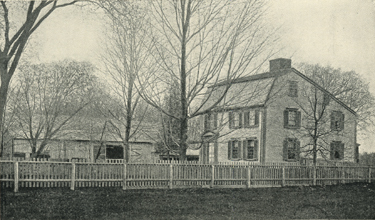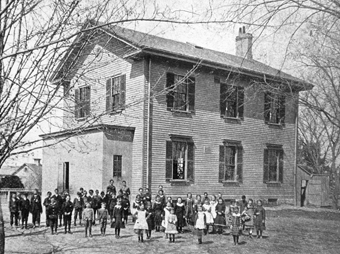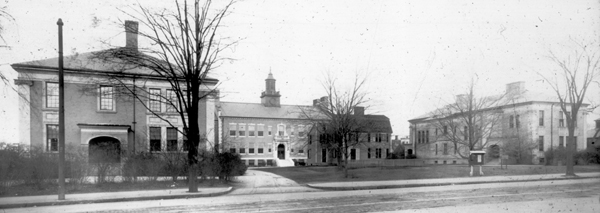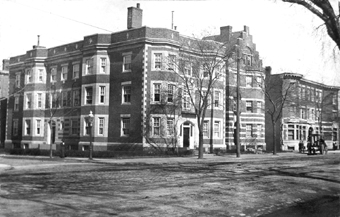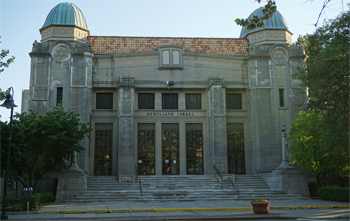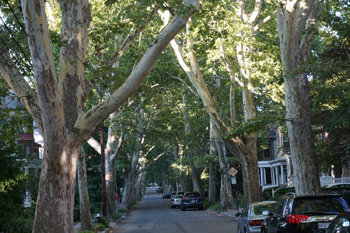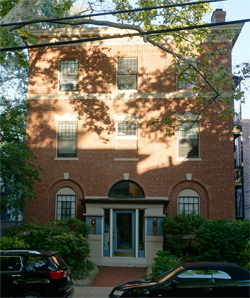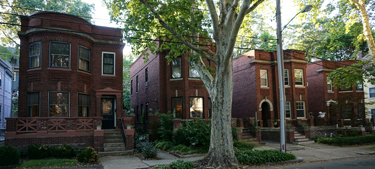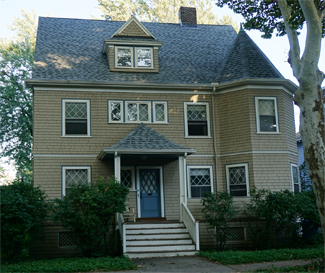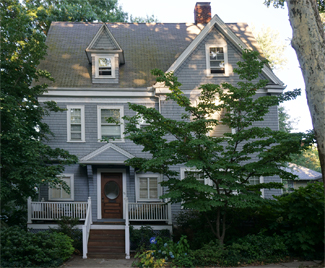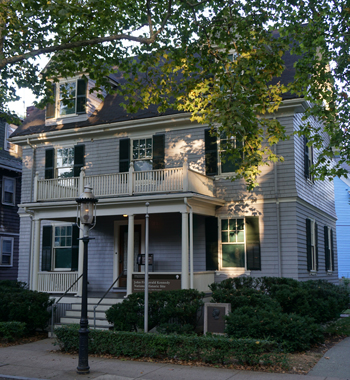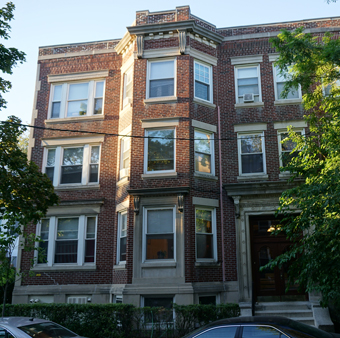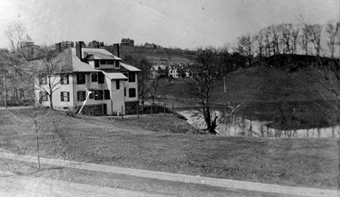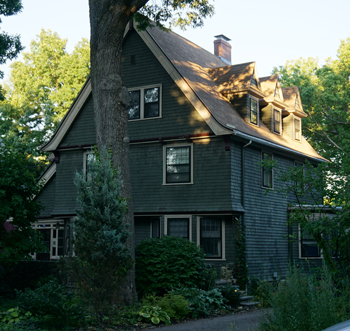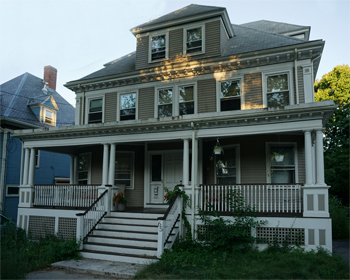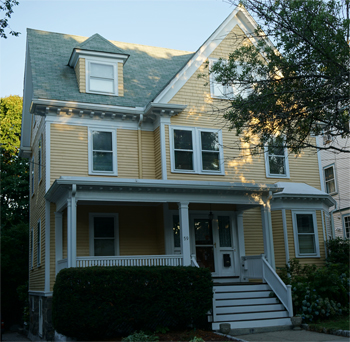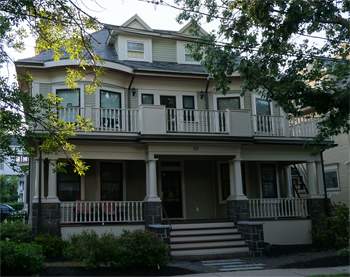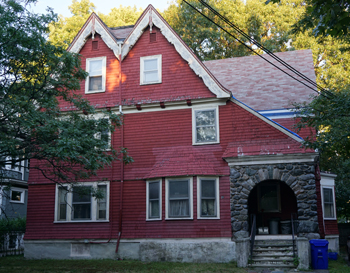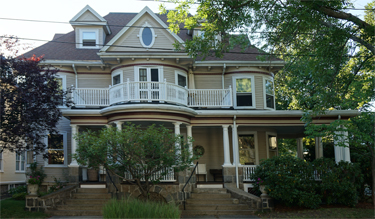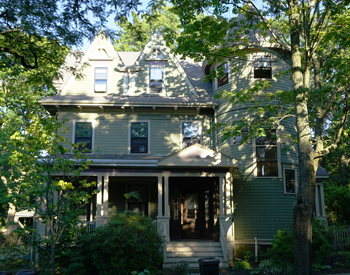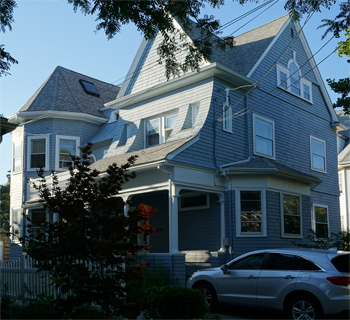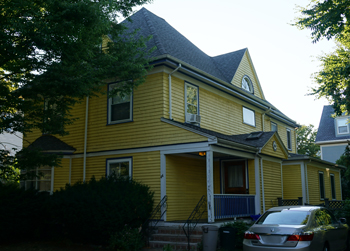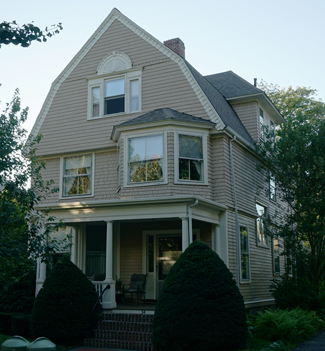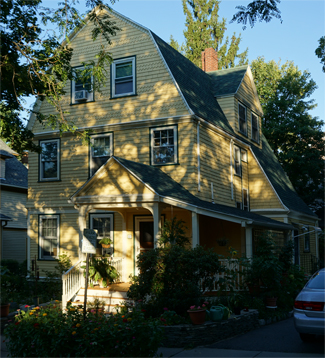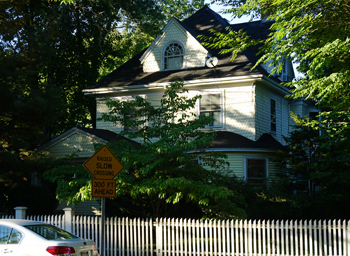Courtesy, Brookline Preservation Commission
- "Devotion House to JFK Birthplace", from the Historic Neighborhood Brochure series, published in 1996.
- "The Babcock Farm and McKayville" from A Guide To North Brookline: Five Walking Tours, published in 1982.
- Print this tour map and follow its indexed locations on this page
- Follow this Google map tour
This tour encompasses two adjoining residential developments and includes Brookline's two major house museums, the Devotion House and the John F. Kennedy Birth Place. These two houses, and the surrounding neighborhood, illustrate the dramatic changes in the history and architecture of Brookline that occurred between 1760 and 1920.
Harvard Street was one of the earliest roads in Brookline, laid out in 1662 "To go...by Goodman Devotions...", according to the Town Report. The road was first known as the Road to the Colleges, and later as the Great Road to Cambridge, for until the Mill Dam across the Back Bay was built in 1821, the only way from Boston to Cambridge led through Brookline.
North Brookline was devoted to farming and large estates well into the 19th century. David H. McKay, starting in 1889, laid out the largest subdivision in North Brookline, developing Coolidge and Thorndike Streets, part of Fuller Street, and Naples Road, while Benjamin B. Newhall's development of Beals and Stedman Streets was begun nine years later. By 1917, the year John F. Kennedy was born, the area of quiet farmland had become a thriving middle class streetcar suburb.
[1] The Devotion house, at 347 Harvard Street, is considered the best example of mid-eighteenth century architecture in Brookline. Bought by the Town in 1891 as a site for a new school and used for a short while to quarter highway department workers the house was almost torn down but a hastily formed preservation group saved it and, in 1911, the Brookline Historical Society took over its management as a house museum and furnished it with belongings of Brookline families, including the Devotions. While it is likely that part of the old Devotion House is incorporated in the present building, stylistically a construction date of c. 1740 seems more appropriate. The gambrel roof, large central chimney, projecting window cornices and pedimented doorway are typical of the Georgian period, as is the elaborately ornamented parlor. It is open to the public and is well worth a visit for those interested in Brookline history.
Edward Devotion was a French Huguenot who had settled in Brookline by 1645. He was active in town affairs for many years, like his sons John and Edward Jr., serving as fence viewer, constable and tithing man. At his death in 1685 he left a dwelling, a barn, and one hundred and two acres situated on both sides of Harvard Street. John sold his inheritance and moved away, but Edward continued farming the family land until 1739 when, aged seventy-one, he sold his seventy-six acres to Solomon Hill. Recorded with the deed in 1740 is a bond signed by Devotion ensuring Hill of "...having and holding and...enjoying forever one certain house and barn and buildings and tracts of land and meadow in Brookline..."
Almost eighty years after Hill's purchase, the property was sold to Boston merchant, Israel Thorndike, for whom Thorndike Street was named. In 1827 the farm was acquired by George Babcock. He was something of an eccentric, wearing a stovepipe hat winter and summer and priding himself on being first at the Boston market with his spring peas (which other farmers swore he planted by punching holes with a crowbar in the still frozen ground). His property later passed to Mrs. Babcock's nephew, and then to the Town.
[2] The first Edward Devotion School was built directly to the right of the Devotion house in 1892. It replaced one which had stood for years in the triangle formed by Beacon, Harvard, and Pleasant Streets. Constructed of brick, stone and terra cotta, the new school was named for Edward Devotion Jr. He was the first benefactor of the public schools of Brookline, leaving, at his death in 1744, a sum equivalent to $3700 to be used "...towards Building or maintaining a school..." The money was invested and not used as originally intended until part of it went towards construction of the 1845 Town Hall which contained two school rooms. The remaining sum was used in 1857 for the Town's first high school building, erected at the site of the new Pierce School.
In 1898 a second school house was built to the left of the Devotion house in response to the area's growing population. By 1913 even more room was needed, and the present central portion of the school, designed by Kilham and Hopkins, was added. This architectural firm, well known in the Boston area for their suburban residential designs, also produced, as the firm of Kilham, Hopkins and Greeley, the design for the Baldwin School. The 1913 building is a yellow brick variation on the Georgian style, perhaps in deference to the Devotion house in front; its gable roof is topped by a louvered cupola and its central facade accented by rusticated Devotion school Today quoins, limestone lintels, and decorative scrolls over the entrance way. The two old structures were demolished in 1953 and 1974 when the present wings were added. President Kennedy and his brother Joseph both attended the Devotion School.
Leaving the school, proceed up Harvard Street to Stedman Street. The land on which it and Beals Street were laid out was, of course, part of the old Babcock farm. The widow Babcock sold a thirteen acre tract, including what was called the pasture lot and the pond, to James M. Beals of the Boston Post. Undeveloped at his death, it was sold to Benjamin B. Newhall, a Boston real estate dealer who moved to Brookline in 1898. He named the streets for the land's previous owner and for the Stedmans, a family which had settled in Brookline as early as 1657. Newhall died when about half of the houses on the two streets had been built; his wife Ellen continued to develop the lots, making arrangements with contractors to build houses at their expense in exchange for a share of the sale price. Both Beals and Stedman Streets are highly developed with fairly small lots, all of them built upon by 1930.
[3] Across Stedman Street, at 373 Harvard Street, is an unusual brick apartment house with stepped gables in the Dutch manner. This three and one half story building, originally housing three apartments, has a polygonal bay, side dormers with stepped gables, and decorative limestone banding. The original owner, Daniel Dewar, was a developer and builder from Roslindale who also built 375 next door in the same year, 1899. The architect for both these buildings was Walter H. Kilham, later a Brookline resident and author of an important book on Victorian architecture, Boston After Bulfinch. He was then a year short of forming his long-lasting partnership with James C. Hopkins. Squeezed between the two apartment blocks is a neighborhood institution, a one story shop called "Irving's Toy & Card Shop" added in 1924. Originally a candy shop, it has been a variety store since 1940. Notice how this small shop is able to stand out from its two large neighbors with the help of a decorative metal cornice.[4] The rapidly growing Jewish population of the early 1900s is symbolized by Temple Kehillath Israel, at the corner of Harvard and Williams Streets. It was designed in 1922 by the firm of MacNaughton and Robinson, and the cornerstone was laid in June of that year. The tablets over the central door and the Star of David on each tower proclaim the faith of the congregation, and the domed square towers call to mind the architecture of the Mid-East. The Chronicle of January 1, 1925, a week before the temple's dedication, stated "the exterior of the temple is of artificial stone with roof of buff terra cotta, the design a monumental treatment of eastern architecture adapted to modern requirements and details. The temple will not only be a home for the orthodox religious worship but also a community center." In 1928 a school and community building were added at the rear of the temple, and the large wing at the corner, designed by Krokyn and Browne in 1947, was built to provide needed space for both social and cultural activities of the congregation.
This was the first temple to be built in Brookline. Its founders, meeting in quarters at Harvard and Thorndike Streets, wanted a more traditional form of worship than existed here at the time, and they established one conforming to the Ancient Rites of Israel, handed down from the oldest Jewish tradition. Now the temple is Conservative rather than Orthodox and is known for its impact on the Conservative movement through the large number of rabbis who have been trained here.
Next, turn right onto Beals Street, which, after Harvard Street's traffic, seems very quiet and in summer, wonderfully shady, with trees planted at such frequent intervals that the street is covered over. There is a variety of middle class homes, in turn-of-the century styles, designed by a number of different architects. The residents typically consisted of men who worked in small businesses, often in Boston. [ed. A typical example would be 38 Beals St. It was first occupied (1906/7-1909) by Charles E. Morey; his wife, Ella Lincoln Tyner; and their teenage sons, Edwin and Richard. Charles Morey was a vice-president of Morey Paper Mill Supply Co. and worked at its Boston office. The Trull family (Herbert Augustus Trull; his first wife, Annie Louise Deland; and the five youngest of their seven children) moved to 38 Beals in 1910. Mr. Trull was a principal in the Boston office of the W. L. McElwain Company, a large manufacturer of shoes. Although he immediately decamped to Boston (at the age of 50 with a much younger woman), Mrs. Trull continued to live on Beals St. for the next 12 years as her children matured and moved out.] A number of the houses have been severely altered over the years with the application of synthetic siding and the removal of decorative trim.
[5] The apartment house at 7 Beals St. is the first stop on this street. Except for Fuller and Gibbs Streets, most of the apartment buildings on the streets covered by this tour are situated near the intersections. This one was built in 1901 by Benjamin Newhall. While the entranceway and the window above it have been altered, the building retains many fine features. The blind arches topped with keystones at the first floor and heavy lintels at the second floor emphasize the different floor levels, and the decorative brick entablature under the classical cornice with dentils and brackets enlivens the facade.
[6] At numbers 34-40 stand four unusual two story brick houses - unusual, in that this type is almost always built as part of a row of attached houses. Here the developers, John Mack and James Moore, bought two lots in 1905, divided each in half and built four narrow houses which were more desirable in the suburbs than row houses, since each had windows on all four sides. The architect, Edward P. Whitman, used many decorative details in brickwork on the facades and emphasized some elements with limestone trim. Notice the clay chimney pots on the roofs and the fact that № 34 and its reverse plan, № 40, share the same type entranceway while numbers 36 and 38 share another.
[7] At 51-53 Beals Street, a large double house on the opposite side of the street built in 1904 (S.J.Rantin, architect), fine classical detailing in the form of modillions, dentils and swags can be seen on the porch entablature; the swags are repeated all across the front of the house just under the roof. Originally there was a balustrade on the porch roof.
[8] Farther up the street, at № 67 and № 73, are two large houses designed by Walter Kilham. In contrast to most of the houses on the street, these two show evidence of a designer who was striving for inventiveness in exterior treatment rather than relying on heavy classical ornament. Built in 1899 for the same owner, they are among the earliest on the street and are more typical of Kilham's work in Brookline than his previously mentioned designs on this tour. While both are similar in shape, massing and siting, their details vary. № 67, with its two story turret and diamond paned windows, has a Queen Anne flavor, while № 73 with a pedimented front gable and dentils at the cornice reflects some Colonial Revival influence. Only the latter retains its original stained shingle covering.
[9] The old streetlight and green paint and gold trim mark the house at 83 Beals Street where President John F. Kennedy was born in 1917. The birthplace of the thirty-fifth President of the United States is maintained by the National Park Service to which President Kennedy's mother gave the house after refurbishing and restoring it to the period of the family's occupancy. Mrs. Kennedy has made tape recordings describing each room and the family activities therein, and the house is open to the public. Joseph P. Kennedy and his wife, Rose Fitzgerald, moved into this house after their wedding trip. He was then President of the Columbia Trust Company of East Boston. Four of the Kennedy children were born here: Joseph Jr., John, Rosemary, and Kathleen. The small size of the house sometimes surprises visitors, but as Douglas Shand Tucci points out in his book, Built in Boston, the Kennedy's were starting their married life here, and the size, location and style of the streetcar suburb house were very appropriate for them at the time. In 1921 the family moved to a larger house at the corner of Abbottsford and Naples Roads nearby. Before leaving, note the house to the right, 77-79 Beals Street, which was built at the same time as the Kennedy house (1909) by Robert Goode who owned both of them. The same scroll-cut boards decorate the window sills of the two houses.
[10] The greater part of the rest of Beals Street was built somewhat later, and the stained shingle houses there reflect the 1920's. At the corner of Beals and Stedman Streets, look across to 103 Stedman, the oldest house on that street. A mansard dating from 1869 and since greatly altered, it is one of the four houses built on Babcock Street by Henry Blaney and was moved to this location in 1902.
Turn left on Gibbs Street, proceeding to Naples Road. While almost all of the street was included in David McKay's purchase, it was not developed by him. It was named for John H. Gibbs, a president of the National Shoe and Leather Company who, in the 1880's, was an agent for the owners of this parcel of land, the largest bought by McKay. On this street are good examples of the three story brick buildings seen so often in North Brookline. Typically, each floor was rented to a single family. Both were designed for developers and builders Snider and Rudnick by F. A. Norcross, who specialized in this type of housing. [11] The building at 19-25 Gibbs is the earlier, built in 1915, and it has classical details, including modillions, limestone quoins, and brackets under the lintels and at the cornice. [12] Across the street, numbers 12-20, built in 1924, have less pronounced bays, and the design of their limestone trim is influenced by Tudor architecture. At Naples Road turn to your left. Here can be seen what remains of Babcock Hill, once much larger. Along the line of Beals Street lay Babcock Swamp with a pond which was drained by a brook starting at the foot of Corey Hill and running to the Charles River. The hill was a large sand and gravel bank, heavily wooded and surrounded by meadows. Children gathered nuts, blueberries and wildflowers there in season, played baseball in the meadows and splashed in the pond in summer and skated on it in winter. William Griggs leased part of this land for many years to pasture his dairy cows. When development of the area began, much of Babcock Hill was used in filling and grading the swamp to the present street level.
Naples Road is a good example of David McKay's development on this side of Harvard Street. It has a wide roadbed, large lots, and substantial houses. McKay was born in New Brunswick, Canada, entered the real estate business on moving to Boston, and saw his opportunity with the advent of the streetcar in Brookline in 1889. He purchased this parcel in 1895 and laid out Naples Road and Fuller, Coolidge, Thorndike, Clarence and Gibbs Streets, financing the endeavor by mortgaging lots and houses on his earlier purchase across Harvard Street. McKay built thirty-two houses on Naples Road, hiring a number of well-known Boston architects who designed in the Colonial Revival, Shingle and Queen Anne styles, or combinations thereof.
[13] At 89 Naples Road is a large shingled house with a steep gable roof, a two story turreted bay, and banded windows in the gable. It is one of McKay's houses, built in 1897, and the difference in size and scale between houses on Beals Street and those on Naples Road becomes immediately apparent here. [14] Another McKay house built the same year, at 73 Naples Road, has the same steeply pitched roof and flared bargeboards as № 89, but the sloping roof over the entrance porch and the use of fieldstone for the porch wall are reminiscent of the house at 21 Naples Road which has fieldstone pillars on its front porch. This echoing of architectural styles and elements (here a combination of Shingle and Queen Anne) throughout the development is one reason for its homogenous character.
[15] 65 Naples Road is a 1903 vernacular interpretation of the Colonial Revival style designed by J. A. Moreshead. It features a hip roof, symmetrical facade, full length porch, and classical details. [16] Another Moreshead design, built next door at № 59 in the same year, has irregular massing and an unusual one story bay; the gable is shingled while the main body of the house is clapboarded.
[17] On the opposite side of the road at the corner of Clarence Street is 50 Naples Road, designed and built by J. H. Davidson, a Dorchester contractor, in 1902. This 1902 house has many Colonial details at the cornice, an elliptical fanlight over the center windows, and Ionic columns on the porch. Next door is another house in the same Colonial Revival style but designed by Edward T. Barker in 1897. These houses illustrate how buildings of similar style and plan were varied using the same Colonial Revival style architectural vocabulary. Both are fairly traditional interpretations of the style.
[18] In contrast is a house in the same style, with one of the few surviving barns in the area, across the street at 41 Naples Road. No architect has been identified yet, but, the proportions of the windows, dormers, and decorative treatments are somewhat 21 Naples Road exaggerated. George D. Pike, in business in Boston like many of his neighbors, built this house in 1898.
[19] At 23 Naples Road is a house with a very unusual shed-type dormer across the front, with four windows and large curving brackets. This 1896 house is one of fifteen designed in the area by the architect Edward T. Barker. In 1906 its owner was the Reverend George L. Perin, minister of the newly-built Beacon Universalist Church (now the Coolidge Corner Theater). [20] Next door at 21 Naples is a McKay house designed by Samuel J. Brown, one of the more original architects hired by that developer. Brown tended to avoid rigid classical symmetry and often employed wood shingles and rounded bays in conjunction with the use of large round fieldstones for porches and foundations. This use of diverse natural materials provides a sharp contrast in textures. Historical ornamentation in his work was usually restricted to gable ends, such as the Tudor verge-board found here. The same ornamentation was used on the house at 12 Naples across the street, also by Brown. A photograph of the completed house at 21 Naples, with the first and second floor plans, was published in the Scientific American Building Monthly in October, 1896, a year after its completion. Originally the roof shingles were wood and painted red.
Developer David H. McKay died in 1898, before he could finish constructing houses all of his property. He was mentioned in The Chronicle's obituary on October 15 as "...McKay, the well known...land developer who has done more than any one, perhaps, to throw into the market the district between Beacon Street and Commonwealth Avenue."
[20A] The last house on the north side, 8 Naples Road, has been extensively altered. It is worth noting, however, that it was built in 1896 fronting Harvard Street. By the 1920s most of the houses on Harvard were being replaced with blocks of small stores. In 1924 this house was moved back on its lot and turned south to front Naples so that another row of stores could be built on what was becoming one of the principal commercial streets in Brookline.
[20B] Turning back towards Clarence Street, notice another Colonial Revival house at 40 Naples Road with classical details and a gabled projecting pavilion with a stained glass Palladian window in the center. Proceed along Clarence Street two blocks to Coolidge Street, which was named, of course, for the Coolidge family from whom McKay bought the land west of Harvard Street.
[21] Turn right to the second house from the corner, № 111-115 . This large Queen Anne style double house has some Colonial Revival details. It was designed for McKay in 1895 by John J. Hasty who built six others nearby. Notice the placement of the windows on the three story turreted bay, the pargetting over the front porch and side window, and the bracketed projecting shingled arch on the side gable. This feature can be seen on another house designed by Hasty at 88 Thorndike Street.
[22] Retrace your steps now, walking towards Harvard Street. At 79 Coolidge Street is a Colonial Revival house built in 1895 for McKay, with a Palladian window in the broken pedimented dormer. It is one of eighteen designed here by Charles E. Park.
[23] Another of his houses is across the street at № 70. Gable-roofed, with a hip-roofed two story bay, it also has an interesting curved wall and roof combination with inset windows. Two other houses, one at 30 Naples Road, also by Park, and one at 100 Coolidge Street, have the same feature.
[24] Next door at № 64 is quite a different type of house. Built in 1903 on Harvard Street and moved by 1907, it shows the influence of the Neo-Rationalist style in its minimal use of ornament.
Across Harvard Street the Joshua Griggs house was located between Coolidge and Thorndike Streets. It was inherited by Griggs' daughter Susan after she married David Coolidge; and here their eight children were born. Coolidge and Thorndike Streets on this side of Harvard Street were laid out after McKay's purchase of the land in 1889. The lots and houses are smaller than those in his later developments, and the architectural designs less ambitious.
[25] Number 49 Coolidge Street is a design by Edward T. Barker that is typical of the street. Gambrel-roofed and shingled, with a front porch, it was built in 1897. [26] At № 44 across the street, notice the dormer with a round-headed window and an unusual pattern of shingles. This house is an 1890 design by the firm of Rand and Taylor, which did twelve houses for McKay, as well as the townhouses at 178-182 Naples Rd.
[27] Number 34 Coolidge Street is another of their designs, very typical of this early development. A 1950's ad for a gambrel-roofed house in this area refers to it as McKay's standard model for "McKayville" in the 1890'S. Another ad, in The Chronicle of October 17, 1891, quoted here in part, describes one of the Coolidge Street houses. "...One enters a large square hall finished in oak...On the first floor, besides the reception hall, are parlor, dining room and kitchen. Parlor finished in white and gold, tiled fire place, oak floor...Sliding doors lead to the dining room... Well-arranged china closet, double pantry. Kitchen...Quaker range, soapstone sink, electric annunciator... ."
[28][29] At 31 and 26 Coolidge Street, both by Rand and Taylor, note the decorative brackets under the overhanging roof of the former and the Shingle Style gable window and interesting window placement on the right hand side of the latter.
[30] Still another 1890 Rand and Taylor gambrel-roofed house, at № 21, is differentiated by the use of bands of patterned shingles at the third floor.
[31] Number 15-17 Coolidge Street, a double house, is very unusual for this area. It was built in 1893 as rental property by Reinhold Klitzke, a baker who lived at the corner of Coolidge and Winchester Streets. His bakery occupied the site of the brick house next door.
[32] At 143 Winchester Street, on the corner, is the house David McKay built for himself when he began his development in 1889. Its intricate shingle patterns, pedimented arch, and first floor bay with a rounded roof are almost identical to those of a house at 50 Thorndike Street by Rand and Taylor, and very probably they were the architects of this house. The building behind the house at 8 Coolidge Street was once the stable on the McKay property. Notice the treatment of the gable window and roof.
David H. McKay died in 1898, before he could finish developing all of his property. He was mentioned in The Chronicle's obituary on October 15 as "...McKay, the well known... land developer who has done more than any one, perhaps, to throw into the market the district between Beacon Street and Commonwealth Avenue."
While this tour ends here, it should be mentioned that another large development bordering this one was begun in 1897, also on former Coolidge land. It included Columbia, Russell, Kenwood and Verndale Streets, and Henry S. Coolidge, grandson of David Coolidge, was the main developer.
© 1986, 1996 Brookline Preservation Commission. All rights reserved.
Originally prepared and printed in 1986 by Carla Benka, Greer Hardwicke, and Leslie Larson, edited and reformated in 1996 by Roger Reed and Greer Hardwicke, funded through the Community Development Block Grant Program of the Department of Housing and Urban Development.
© 2015 Brookline Historical Society
